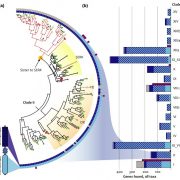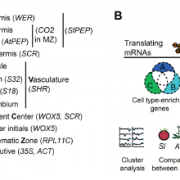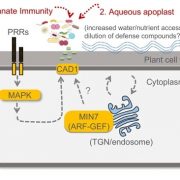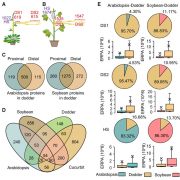
Evolution of tetraploid meiosis (PNAS)
Plant Science Research WeeklyGenome duplications are common in plants and thought to be an important contributor to evolutionary innovations, but the increase in ploidy that results from a genome duplication also presents challenges for reproduction. Because there are four sets of homologous chromosomes in the derived tetraploid…

A regulatory module for survival on low potassium (Nature Plants)
Plant Science Research WeeklyPotassium ions (K+) play a variety of important roles in plant physiology and are maintained at a high concentration in the cytosol relative to the available K+ in the environment. Potassium may accumulate to an even higher concentration in the vacuole, where it helps to regulate turgor pressure. During…

Maize aquaporin PIP2;5 alters water relations and plant growth (Plant Physiol)
Plant Science Research WeeklyAquaporins, also known as water channels, are conserved across all kingdoms. In plants, the plasma membrane intrinsic protein (PIP) subfamily controls membrane water permeability. Maize aquaporin PIP2;5 is highly expressed in roots. By reverse genetic approaches, Ding et al. showed that overexpression…

Structural evolution drives diversification of the large LRR-RLK gene family (New Phytol)
Plant Science Research WeeklyLeucine-rich repeat receptor-like kinases (LRR-RLKs) act as signaling receptors, are the largest plant-specific protein kinase family, and are involved in myriad developmental activities and defense systems. Due to the large number of proteins in this group, their diversification and consequent redundancy…

Mystery of adventitious root formation in grapevine (Plant Physiol)
Plant Science Research WeeklyGrapevines (Vitis vinifera L.) are clonally propagated by stem cuttings, which depends on the formation of adventitious (stem-borne) roots. In this paper Chen at al., showed the function of microRNA encoded peptides (miPEPs) in adventitious root formation of cultured grape plantlets. MicroRNA biogenesis…

Innovation, conservation, and repurposing of gene function in plant root cell type development (bioRxiv)
Plant Science Research WeeklyRoots have many specialized cells arranged in concentric circles that are functionally homologous among various plant species but with varying cell-type-specific developmental programs. To further understand these developmental programs, Kajala et al. performed TRAPseq (Translating Ribosome Affinity…

Trichomes: a means for foliar water uptake (FWU) (Plant J)
Plant Science Research WeeklyFoliar water uptake (FWU); water uptake through the leaf surface, is observed in several species and helps in drought conditions through water uptake from fog, snow, dew and rain. In this paper, Schreel et al. showed trichomes as a major source of FWU in beech (Fagus sylvatica L.) plants. Trichomes are…

How plants keep their microbiota healthy (Nature)
Plant Science Research WeeklyThe large apoplastic intercellular space of plant leaves creates nutrient-rich niches for microbial colonization. To date, whether and how plants control the composition of leaf microbiota is poorly understood. Chen et al. reported that the Arabidopsis quadruple mutant (min7fls2efrcerk1 or mfec)…

Extensive inter-plant protein transfer between Cuscuta parasites and their host plants (Mol. Plant)
Plant Science Research WeeklyCuscuta (dodders) are parasites that survive on other host plants.Liu et al. found more than 1500 proteins are transferred between Cucuta and host plants forming a sort of interplant chemical communication. Furthermore, proteins could move between two hosts that are connected by dodder bridges, and retain…

